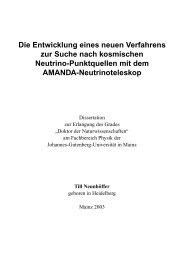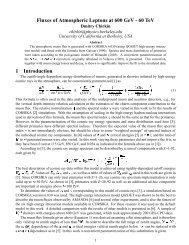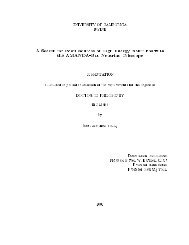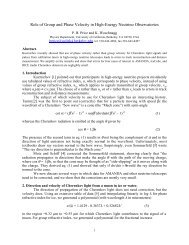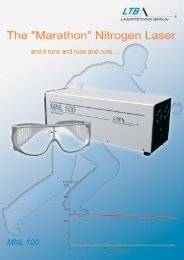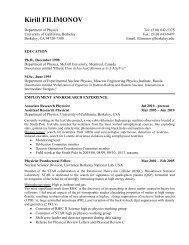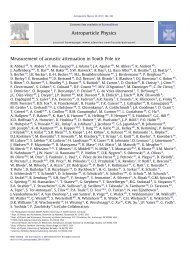Link to Fulltext
Link to Fulltext
Link to Fulltext
You also want an ePaper? Increase the reach of your titles
YUMPU automatically turns print PDFs into web optimized ePapers that Google loves.
Along with ¡ collisions in the infalling gas , producing § © according <strong>to</strong> Eq. 1, pho<strong>to</strong>production<br />
of pions can take place in the optically thick pho<strong>to</strong>n field around the core according <strong>to</strong>:<br />
¡ ¥<br />
¡ ¥<br />
followed by neutrino production from § decay. If the pho<strong>to</strong>n density is very high relative <strong>to</strong> the<br />
¢ ¡ ¥ ¡ ©<br />
¡ ¥ ¡§ ©<br />
pho<strong>to</strong>ns:¢<br />
pro<strong>to</strong>n density, these processes will dominate over collisions. Also, if the radiation is strong<br />
enough in the disk, all pho<strong>to</strong>ns will lose energy in interactions and all electrons<br />
and pho<strong>to</strong>ns cascade down <strong>to</strong> energies around 100 GeV by inverse Comp<strong>to</strong>n scattering and pair<br />
production [19]. Neutrons with energies high enough from Eq. 11 can also produce mesons via<br />
interactions with , contributing further down <strong>to</strong> neutrino (both <br />
and<br />
) production.<br />
Pro<strong>to</strong>n energy loss by interaction with pho<strong>to</strong>ns (Eq. 11) starts at a threshold -energy <br />
¢ ¢¡<br />
which ¥<br />
yields a pro<strong>to</strong>n energy of TeV for the<br />
£ UV<br />
¡<br />
bump [18]. The<br />
lack of strong X-ray absorption [18] could indicate that the energy loss by reactions is<br />
smaller, due <strong>to</strong> a lower pro<strong>to</strong>n density compared<br />
¡ ¥ ¡ ¡ <br />
<strong>to</strong> pho<strong>to</strong>ns. Energy loss by pair production<br />
©<br />
is also small, because of the low mass of the electron. It is however<br />
the dominant process at pro<strong>to</strong>n energies between 30-3000 TeV [10]. Below a certain energy, the<br />
pro<strong>to</strong>n interaction length with pho<strong>to</strong>ns is larger than the radius of the optically thick region and<br />
they can escape. Thus, neutrinos are expected <strong>to</strong> follow the pro<strong>to</strong>n energy spectrum down <strong>to</strong> that<br />
¡ <br />
energy, estimated <strong>to</strong> ¥ [10].<br />
Several AGN have been reported <strong>to</strong> emit GeV pho<strong>to</strong>ns with a variability of the order of days<br />
(flares), all of them radio-loud. Markarian 421 has even been observed <strong>to</strong> emit TeV pho<strong>to</strong>ns [21].<br />
These high pho<strong>to</strong>n energies could be explained by inverse Comp<strong>to</strong>n scattering of accelerated<br />
electrons in the jets [10]. If the magnetic energy density above the<br />
¡<br />
disk<br />
¥<br />
is<br />
§<br />
larger<br />
¡<br />
than<br />
<br />
the<br />
¥ ¡ ¡<br />
radia-<br />
<br />
tion density, the pho<strong>to</strong>ns produced in<br />
can produce <br />
© pairs via<br />
interaction with the magnetic field. A cascade of such pair production and synchrotron radiation<br />
would develop and could provide a spectrum extending up <strong>to</strong><br />
¡<br />
100<br />
¥<br />
TeV<br />
§<br />
[19].<br />
¥<br />
Yet<br />
<br />
another<br />
<br />
possibility<br />
is that those very high energy <br />
pho<strong>to</strong>ns could have a hadronic origin, from<br />
decay in the jets, with subsequent electromagnetic cascading of the pho<strong>to</strong>ns down <strong>to</strong> energies<br />
for which the accelerating region is transparent.<br />
¡ ¥<br />
Since<br />
¡§ <br />
this process would be accompanied by<br />
, this model would be favored by the ¢<br />
detection of high energy<br />
<br />
neutrino observations<br />
from AGN [10]. interactions could accompany , if the pro<strong>to</strong>n density is ¢ high enough<br />
in the jets, and still be compatible with the time variability of the observations<br />
<br />
[20]. Predictions<br />
¢¡ <br />
for a detec<strong>to</strong>r with a threshold energy of 1 TeV vary between a few <br />
up <strong>to</strong> several hundreds<br />
of events/year integrated over all AGN, depending on the production model (a compilation<br />
can be found in [20]).<br />
The large uncertainty is due <strong>to</strong> the difficulty <strong>to</strong> put constraints on the model in order <strong>to</strong> produce<br />
the observed pho<strong>to</strong>n fluxes at various wavelengths,<br />
<br />
the<br />
<br />
unknown fraction of luminosity participating<br />
in nucleon interaction [10] and also <strong>to</strong> how strong the attenuation of pho<strong>to</strong>ns by reactions<br />
with extragalactic pho<strong>to</strong>ns really is [21]. It is believed that only close AGN can be observed<br />
at very high gamma energies [22], whereas observations of neutrinos could be made at much<br />
higher energies. This prediction is based on the fact that the cross section for pair-production in<br />
interactions off intergalactic infrared light is maximized at 1 TeV.<br />
<br />
¢<br />
¡§ <br />
¡§<br />
<br />
8<br />
(11)



